As a kid, I got $5 in pocket money each week.
For months, I received my weekly $5, but one day, my mum decided to increase the amount to $7.
No complaints from me. 😊
Since my parents increased my allowance only every few months, we could classify it as a 'rarely changing value'.
In programming, 'rarely changing values' are strings and quantities that remain unchanged for months or years. Since they may change occasionally, we want to make such values configurable.
Rarely changing values should go into application configuration.
Configurations also help us set different values for each deployment environment. Database connection strings will differ between development, staging and production environments.
Once we have our rarely-changing, per-environment application values defined in configuration, we are free to alter the values without having to recompile and redeploy the application. However, we must retest the software since the configured values will affect the system's operation.
Stage 1 (Beginner): Hardcoding
As a brand-new programmer, I had no appreciation for configuration. I hardcoded everything. I still had much to learn.
At first, I didn't realise that defining sensitive configuration data in source code, such as production connection strings or admin credentials, represented the worst type of security sin: These will be available for mischief to anyone with read access to the source control repo. (In the 1990s, there was no git).
An Example
Let's say you want to develop a polymorphic (or 'pluggable') general emailer that uses AWS Simple Email Service (SES) as the underlying technology. You've decided to use C#.NET.
You have created the below IEmailer interface, providing pluggable emailing technology to higher-level classes.
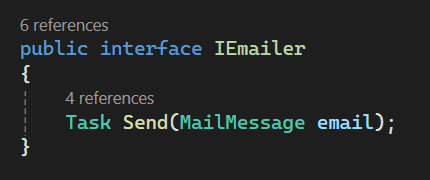
IEmailer implementations could be SmtpEmailer, AzureSendgridEmailer, and, of course, AwsEmailer.
Below, you have much of the listing for AwsEmailer, the general-purpose emailing class for AWS SES, including the implementation of the public Send() method:

Looks pretty clean, right?
And yet, there is a big problem.
Have you spotted it?
That's right: ClientFactory.Create() takes in a hard-coded RegionEndpoint.
Tough luck if we ever change our minds and want to use a different region than APSoutheast2!
Here, we have an excellent candidate for configuration: A value varying by deployment environment and time. Today, we're using RegionEndpoint.APSoutheast2, and in 6 months, it might be RegionEndpoint.USEast1.
Hardcoding the AWS Region for your AwsEmailer component is something no self-respecting senior developer would do.
Why lock this beautifully reusable general AWS SES Emailer class into a specific AWS Region??
It doesn't make sense.
Alright, let's improve our AwsEmailer by making the AWS Region configurable.
Stage 2 (Senior Dev): Native Configuration
A modern approach to configuration in .NET is using an appsettings.json config file, and read the configuration values via IOptions.
Note: I'm only supplying the implementation details for the sake of completeness. It's probably best to only skim the images and code for Stage 2.
Here is the updated AwsEmailer:
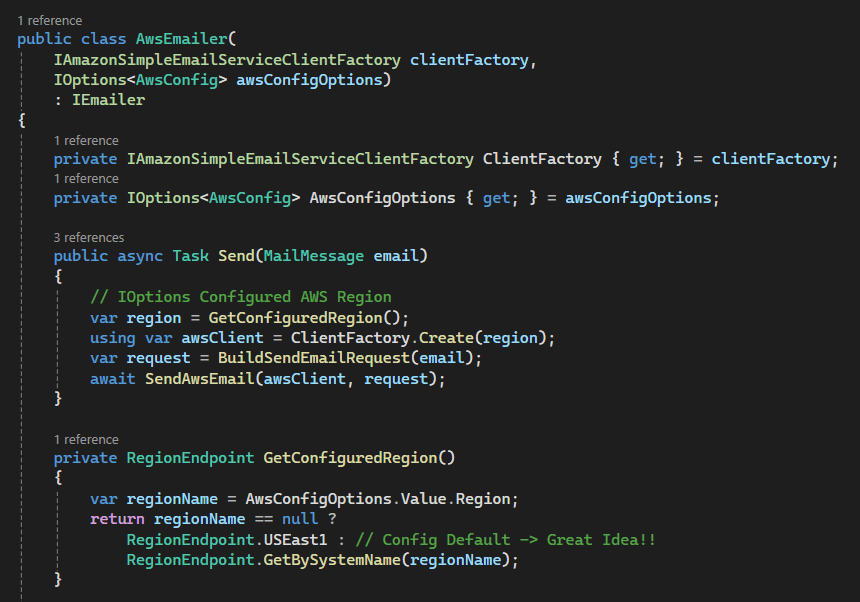
We're now using the generic IOptions<T> pattern and appsettings.json data file as the new way to configure .NET apps.
I don't want to get too deep into how to use IOptions<T>. I will say that we require an appsettings.json configuration file containing the JSON data of custom configuration values. Below, we have defined the AWS-specific config values in the AwsConfig node:
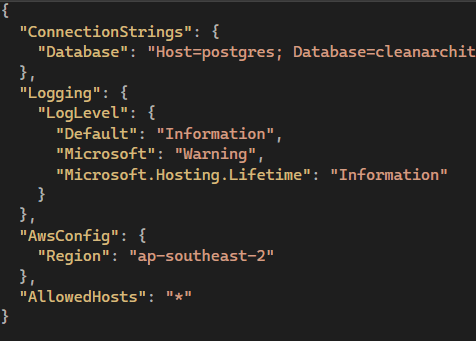
We must also have a companion AwsConfig class, record or struct:
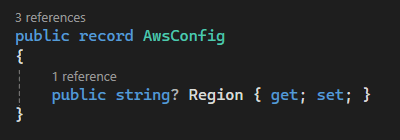
Lastly, we need to configure our Inversion of Control (IoC) container to map the 'AwsConfig' configuration section to the AwsConfig record in the ASP.NET Web API project's Startup.cs file.

IOptions<T> is one way of configuring a .NET application. There are others. We could configure our system from CSV or XML files, a database or even a remote service.
I acknowledge IOptions<T> as an effective and easy-to-implement configuration method. I would choose it to configure my .NET apps.
In that case, why do I not consider IOptions<T> as the pinnacle of configuration?
I have several reasons:
- Open-Closed Principle (OCP) Violation. The OCP encourages us to prefer code open to extension rather than code needing to be modified. In our example, if we ever wanted to change to a different way of configuring
AwsEmailer, a database or a custom XML config file,AwsEmailerwould need to be modified. The out-of-the-box implementation ofIOptions<T>configuration works by reading config values from anappsettings.jsonfile. A change in configuration mechanism would mean we'd need to write a custom implementation ofIOptions<T>for reading from database or XML file (too complicated), or we can abstract away the configuration mechanism. More on this shortly. - Distracting Complexity. Here, I'm making a subtle but crucial point. The mechanistic complication of
IOptions<T>, disproportionally impinges on the readability ofAwsEmailer, especially given that configuration is not a central concern for this class.AwsEmailersends emails using AWS SES. The fact that we are retrieving a required value (AWS Region) should not take centre stage. I have reduced the overbearing complexity by extracting the logic to configure the AWS Region into a separate helper method. Still, I think theIOptions<AwsConfig>primary constructor parameter draws my eye every time I read the code. I can see how a junior developer might get confused about the low importance ofIOptions<AwsConfig>inAwsEmailer.
Stage 3 (Master): Abstracting away Configuration Mechanics
Why should the configuration mechanics be part of a class only interested in consuming a config value?
The answer: "It shouldn't."
Let's create an abstraction for the AWS Configuration data, IAmazonConfiguration:
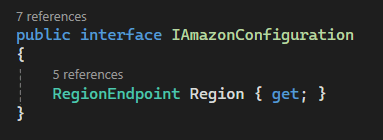
Consequently, AwsEmailer simplifies to
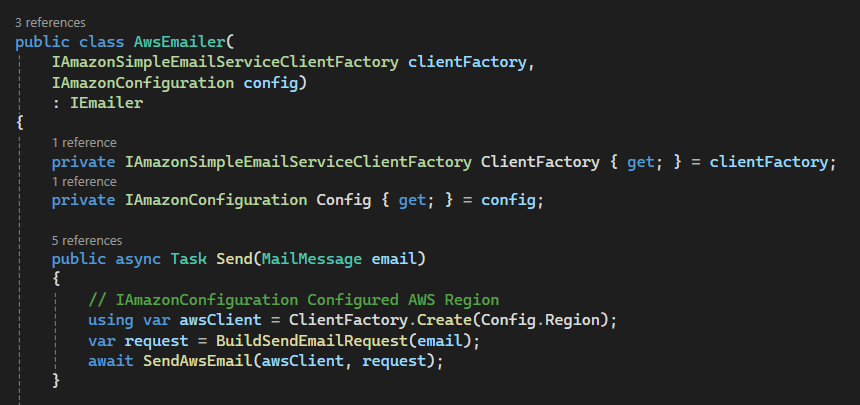
The AWS Region value comes from implementers of IAmazonConfiguration, for example, an AppSettingsAmazonConfiguration, which retrieves the desired AWS Region from the appsettings.json file, as before:

We have the same configuration process as before, but we have simplified AwsEmailer by separating the configuration retrieval into a new class!
Here are a few advantages in favour of this approach:
- OCP Compliance. Switching over to obtaining configuration values from a SQL Server database, we only need to write a
SqlServerAmazonConfigurationclass implementingIAmazonConfiguration.AwsEmailerdoes not need to change at all! - Sheer Simplicity.
AwsEmaileris no longer overwhelmed by configuration concerns. All we have is a simple reference toIAmazonConfigurationand a call to theConfig.Regionproperty, and that's it. - Easier Mocking. I bet mocking
IAmazonConfigurationin unit tests is a little more straightforward than a generic interface likeIOptions<T>.
Some people will instinctively lob a grenade and scream "Overengineering". Only a few years ago, I would have joined that chorus.
Through hard-won experience on many projects, I have learned that favouring a complexity-minimising approach will pay dividends in the form of highly understandable and flexible systems.
My Secret: Flexible Hardcoding
Sometimes, when I develop core functionality, like AwsEmailer, I want to carry on with core work and not get distracted by writing boilerplate configuration code.
When I feel like that, I may write a configuration class with hard-coded values.

In the case of AwsEmailer, I may create a HardcodedAmazonConfiguration class. Yes, I genuinely name it that!

HardcodedAmazonConfiguration sets the AWS Region to my preferred development region, APSoutheast2.
Once I've configured my IoC to use HardcodedAmazonConfiguration in development, I can run my local development environment, and AwsEmailer will use APSoutheast2!
I call it 'Flexible Hardcoding'. I'm using a fixed configuration value, but the configuration mechanism is pluggable (via IAmazonConfiguration), and one way to use it is to plug in a provider of hard-coded, fixed values! No changes need to be made to AwsEmailer to do so.
Direct hardcoding poses the most problems when we need to change existing code.
When I feel like working on something less taxing, I will write the dynamic appsettings.json configuration.
Caution
- I am careful to indicate the fixed nature of hardcoded configuration classes.
- I replace hardcoded configurations before a production deployment. Hardcoded configurations are only valuable for development.
Conclusion
When we face different strings or quantities in production and development, or those values change from time to time, we should set up those values to be configurable.
Novice programmers tend to overdo hard-coding, and seniors know how to implement a useful configuration structure. However, master software engineers know how to inject further flexibility into a program by abstracting the configuration mechanics from the place using those configuration values!

